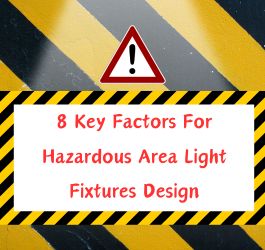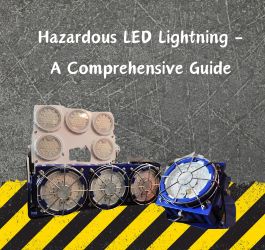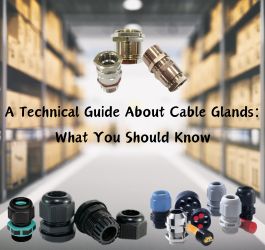In certain scenarios, the term 'hazardous location LED lighting' is used to describe lighting fixtures purposefully engineered for safe operation in environments characterized by abnormal conditions. In industrial settings, where the likelihood of encountering hazards is notably higher, the role of lighting becomes pivotal in instilling both a sense of safety and enhanced visibility.
Within this domain, the term 'hazard' specifically refers to materials with flammable, combustible, or ignitable properties—such as fibers, gases, dust, or vapors. The potential intersection of electrical equipment, exemplified by commercial warehouse LED lights, with these hazardous materials can lead to severe consequences.
According to Mordor Intelligence, the Hazardous Location LED Lighting sector is anticipated to achieve a market value of USD 636.6 million by 2025, reflecting a compound annual growth rate (CAGR) of 8.86% over the period from 2020 to 2025. This projection highlights the steady expansion of the market for safe and efficient lighting solutions in hazardous environments.
Consequently, the meticulous selection of a reliable LED wholesaler becomes crucial to mitigate the risks associated with hazardous environments and maintain stringent workplace safety standards. This article aims to provide comprehensive insights into hazardous areas, their classification, and the critical considerations essential when choosing a secure LED wholesaler.
A nuanced understanding of the intricacies of hazardous environments empowers stakeholders to make informed decisions, fortifying safety protocols within industrial landscapes.Table Of Contents
What Is A Hazardous Area?

A 'hazardous area' is characterized as a space where the atmosphere either contains, or has the potential to contain, significant quantities of flammable or explosive gases, dusts, or vapors. In such an environment, the risk of a fire or explosion arises when three fundamental conditions converge. This concept is commonly known as the 'hazardous area' or 'combustion' triangle.
Lighting fixtures installed in such areas must undergo specialized design to meet stringent safety standards. Rigorous testing is imperative to guarantee the safety of these fixtures. Ensuring that lighting fixtures are not only designed for functionality but also undergo thorough testing is paramount.
This approach not only enhances safety but also prevents potential hazardous situations that may arise from the reactions of lighting fixtures with the surrounding environment.
Classification of Hazardous Zones
The information provided serves as a general guide.
In adherence to the stringent guidelines set forth by the Health and Safety Executive (HSE), employers are obligated to categorize areas where potentially hazardous explosive atmospheres could arise into specific zones. The classification assigned to a particular zone, along with its size and location, is contingent upon the likelihood and persistence of an explosive atmosphere.
Manufacturers of luminaires, responsible for producing lighting fittings designed for hazardous areas, can only offer guidance on the type of luminaire, not on the determination of the zone in which it should be utilized.
Lighting for Gas Explosive Atmospheres & Zones
| Single Compression | Presence of Explosive Atmospheres |
|---|---|
| Zone 0 | Continuous or frequent presence |
| Zone 1 | Occurring occasionally during normal operation |
| Zone 2 | Not expected during regular operations. However, if such an atmosphere does occur, it is anticipated to be of short duration. |
Lighting for Dust Explosive Atmospheres & Zones
| Single Compression | Presence of Explosive Atmospheres |
|---|---|
| Zone 20 | Continuous or frequent presence |
| Zone 21 | Occurring occasionally during normal operation |
| Zone 22 | Not expected during standard operations. However, if such an atmosphere does manifest, it is anticipated to persist for a brief period only |
What Types Of Industries Require Hazardous Location Lighting?

Identifying target industries is straightforward, encompassing those dealing with substances like flammable gases or vapors, combustible liquids, ignitable fibers, and other materials. This includes chemical plants, oil/gas refineries, pulp and paper mills, steel mills, as well as maritime industries. Additionally, any manufacturing applications involving high temperatures or combustible materials fall into this category.
Some companies, even if not part of the common industries, require hazardous location lighting for storage areas or other facilities. For instance, wastewater treatment plants handle liquid gas, and certain agricultural products like flour are highly combustible. Surprisingly, even apparently 'clean' facilities such as clothing manufacturing plants can produce combustible dust fibers.
What Singapore Industry Standards Apply?

To ensure the appropriate lighting fixtures are used in hazardous environments, various industry groups and regulatory bodies have established standards. For instance, IEC 60079-10-1:2020 focuses on categorizing areas prone to flammable gas or vapor hazards.
This classification serves as a foundation for guiding the effective design, construction, operation, and maintenance of equipment intended for use in hazardous environments.
What Is The Hazardous Area Directive?
ATEX

ATEX, also known as “ATmosphere EXplosible”, is a European directive, outlines safety measures for equipment used in potentially explosive atmospheres. Manufacturers in the European Community, including those producing lighting products, are legally required to follow the ATEX directive. This involves maintaining certificates as proof of compliance.
In some regions, alternative standards such as IECEx are accepted, aligning with similar principles. While meeting technical requirements for different explosion protection methods, the ATEX directive also adds extra responsibilities for certificate holders.
This includes having a solid quality assurance system, detailed product documentation, clear installation information, understanding potential limitations in specific environments, providing labeling information, and more.
In essence, ATEX not only sets technical standards but also emphasizes a strong quality framework, thorough product documentation, and strict adherence to safety measures. This ensures that equipment, especially lighting products, meets the highest safety standards for use in potentially explosive atmospheres.
IECEX

The IECEx directive helps ease the process of sharing and accepting safety test results among different laboratories worldwide. This means that a product tested and certified in one country can be accepted in other countries without needing to go through additional testing.
Recognized and supported by the United Nations, the IECEx certification system is widely acknowledged internationally. It's essentially a stamp of approval that ensures the safety of equipment, services, and personnel involved in systems used in explosive environments.
International Classifications

Apart from the well-known international hazardous area classifications like ATEX and IECEx, there are several other standards used in specific regions for marking and purchasing equipment. For example, INMETRO is used in Brazil, GOST is applied in Russia and Ukraine, and NEC is relevant in North America.
These classifications ensure that equipment meets the necessary safety standards and regulations in their respective regions.
Why Use LED Lights in Hazardous Areas?

Hazardous location lights play a crucial role in safeguarding workers within potentially dangerous environments. With the rise in safety regulations and the broader accessibility of technology, LED hazardous location lights have gained growing popularity.
While it may no longer be the latest standard in the EU, it retains significance among manufacturers as a means to communicate types of glands and their essential features. Among the most prevalent types and designations are:
Things To Consider When Choosing Hazardous LED Lightings?
A challenging aspect of selecting luminaires for hazardous area lighting lies in the variance between manufacturers who may quote luminaire lumens or simply lumens (lamp lumens). Luminaire lumens represent the measured light output produced by the luminaire once the LED is installed.
This measurement considers efficiency losses through the luminaire's diffuser and factors in any design aspects that may impact efficiency. On the other hand, lumens or lamp lumens refer to light outputs directly measured at the LED source, excluding losses or inefficiencies of the luminaire.
This distinction is particularly crucial in hazardous area lighting, given the protection concepts manufacturers employ to achieve 'zone certified' products.
Many manufacturers employ encapsulation or lensing arrangements to meet industry standards. While these protection concepts enhance safety, they can introduce additional materials that may reduce light output.
Considering this, it becomes crucial to verify with the manufacturer whether the quoted figures represent true luminaire lumen values, supported by photometric test data. Seeking this confirmation ensures a genuine like-for-like comparison when making specification decisions.
Moreover, It is advisable to request specific lighting design details or proof of lumen output claims from the manufacturer. The significance of lighting design will be further discussed in later sections of this document.
Service Life
Another significant advantage of LED lighting is its exceptionally long service life, typically ranging from 30,000 to 100,000+ hours of operation. This prolonged lifespan holds particular relevance in hazardous environments, where the maintenance of lighting is both perilous and economically burdensome.
In contrast to traditional light sources, maintaining LEDs can significantly reduce the need for frequent lamp changes. Traditional maintenance practices in hazardous areas often involve shutting down site operations to facilitate lamp replacements.
Consequently, many sites postpone lamp maintenance until absolutely necessary, usually when the lack of working lighting begins to compromise safety in an area. The costs associated with such shutdowns can be substantial, impacting overall site production.
Light Colour & CRI (Colour Rendering Index)
The light emitted by LEDs consists of wavelengths with specific colors determined by the semiconductor material. One common method of generating white light is through the property of photoluminescence.
In this approach, an LED that produces blue light is coated with a thin layer of phosphor. When the LED is turned on, the blue wavelength passing through the phosphor produces white light. The color temperature, measured in Kelvins, is controlled by the mix of phosphor used.

Generally, the warmer the white light, the less efficient the conversion from blue to white.
Common color temperatures include:
| 2700K – 3200K | Warm White Light |
| 4000K – 4500K | Natural White Light |
| 5000K – 5500K | Day White Light |
The
Interestingly, the common SOX or low-pressure sodium lamp, still used in external lighting, has a CRI of 0, meaning it doesn't accurately represent any color under this lighting.
In hazardous area lighting, certain protection concepts can impact both color temperature and CRI. The encapsulation of the LED light source within a hazardous area luminaire can make the color temperature cooler.
For example, a 4000K LED may have a tested color temperature of around 7000K when encapsulated due to the removal of the air gap in front of the phosphor. However, the CRI can improve once the LED is encapsulated. In the given example, the CRI improved from 85 to 90, indicating excellent color rendition despite the cooler color temperature.
Hazardous Area Lighting Design

While hazardous area light fixtures are subject to rigorous safety standards, these standards often overlook considerations related to luminaire performance and reliability. However, failure of these lights not only compromises workplace safety but also leads to a substantial increase in maintenance costs.
Key factors to consider :
- Efficient heat dispersion
- Premium corrosion shielding
- Resilience in extreme temperature conditions
- Temperature Ratings
- Dust and Moisture Resistance
- Impact and Vibration Protection
- Surge Protection
We've written an article on the 8 key factors for hazardous area light fixture design . If you require further information on this topic, please feel free to refer to the article.
Traceability of lighting products
Ensuring traceability of all products and components used in hazardous area lighting is paramount for manufacturers. It's crucial that your chosen manufacturer maintains complete visibility into its supply chain and manufacturing partners.
Given the intricacies of the manufacturing and approval processes, manufacturers must be proactive in anticipating any material changes that could impact current product certifications.
Each luminaire should be assigned a unique serial number, enabling traceability back to its specific manufacturing time and method. This level of detail ensures accountability and transparency throughout the product's lifecycle.
Hazardous LED lighting warranty provider

The warranty landscape has become a significant factor in both marketing strategies and customer concerns, especially within the hazardous area and LED lighting sectors. Some suppliers are offering warranties of up to 10 or 15 years without adequate knowledge of the installation conditions.
In many cases, these suppliers may have less operational history than the warranty they offer, raising doubts about the reliability of such guarantees. A reputable supplier or manufacturer will always support their product, but before extending any warranty, they'll need detailed information about the installation environment.
This is particularly critical in hazardous area installations, where the conditions can be significantly more demanding on luminaires compared to standard office or industrial settings.
Supplier reliability and track record
Trust is a crucial aspect when selecting a supplier. Before choosing a manufacturer or supplier, it's essential to gather information about them. How long have they been in business? Are they known for their reliability and reputation? Do they have in-house design facilities, or do they import lighting products? Visiting their website to see their products being produced can provide valuable insights.
A reputable manufacturer will welcome potential customers to visit their facilities and share details of past projects. Additionally, speaking to other clients who have worked with them can offer firsthand experiences. Take, for instance, SOPEX Innovation .

With over a decade of expertise and technical proficiency, SOPEX prioritizes designing and developing optimal LED solutions. They specialize in green and innovative, energy-efficient technologies tailored to withstand not only the demanding marine environment, but hazardous environments too. Their inventory boasts a diverse range of explosion-proof LED lights for customers to explore.
Moreover, not only do they offer ROI calculations for LED projects, including retrofits and replacements, but they also provide on-board inspections by their in-house engineers. This ensures customized solutions for every project.
Conclusion
This comprehensive guide has delved into the intricacies of hazardous LED lighting, covering key considerations such as explosion-proof construction, zone classifications, industry standards, and the importance of supplier reliability.
By understanding the unique challenges and requirements of hazardous areas, businesses can make informed decisions to ensure workplace safety and regulatory compliance. We’ve written a guide on how to identify a well-designed hazardous LED light too.
Moreover, with careful consideration and adherence to industry best practices, the hazardous area LED lighting sector holds immense potential for driving safety, productivity, and sustainability in industrial landscapes.










